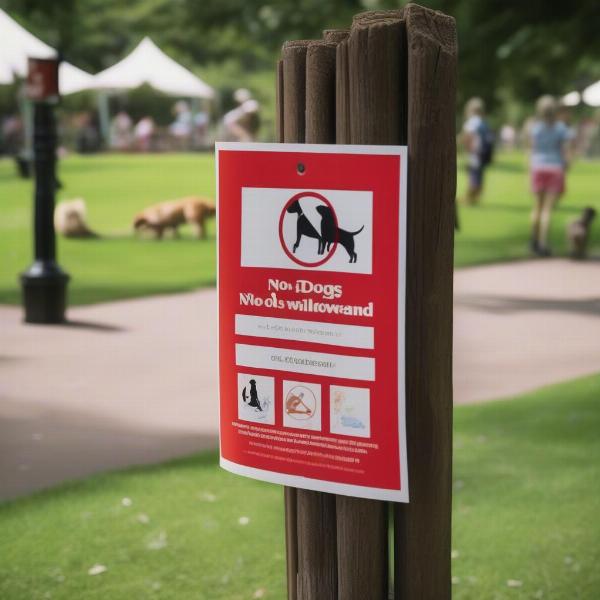“No dogs” signs can be a frustrating sight for dog lovers. Understanding why these policies exist, where they apply, and how to respect them is essential for responsible dog ownership. This guide explores the nuances of “no dogs” rules, offering practical advice for navigating these situations and ensuring a harmonious environment for everyone.
Understanding “No Dogs” Signs
 No Dogs Allowed Sign in a Public Park
No Dogs Allowed Sign in a Public Park
“No dogs” signs communicate a restriction on the presence of dogs in a specific area. These restrictions are often in place for reasons related to hygiene, safety, or the preservation of natural habitats. For example, food establishments often prohibit dogs for hygiene reasons, while some beaches may restrict dogs during nesting season to protect vulnerable wildlife. Businesses, private properties, and public spaces may all implement “no dogs” policies. Recognizing and respecting these policies is crucial.
Exceptions to the Rule: Service Dogs
A key exception to “no dogs” policies involves service dogs. These highly trained animals assist individuals with disabilities and are legally permitted access to most establishments, regardless of pet policies. It’s important to understand the distinction between service dogs and emotional support animals (ESAs). While ESAs provide comfort, they do not have the same public access rights as service dogs. Business owners are generally allowed to inquire about the nature of a service dog’s tasks but cannot request documentation or proof of disability.
Finding Dog-Friendly Alternatives
When faced with a “no dogs” sign, finding dog-friendly alternatives is the best course of action. Numerous online resources and apps can help locate dog parks, beaches, hiking trails, and even restaurants that welcome canine companions. Planning ahead and researching dog-friendly options can make outings with your dog much smoother and more enjoyable. Consider factors like your dog’s temperament and energy level when choosing activities and locations. For instance, a bustling city park might not be suitable for a shy or reactive dog.
Promoting Responsible Dog Ownership
Respecting “no dogs” policies contributes to responsible dog ownership and fosters positive relationships between dog owners and the wider community. Always keep your dog leashed in public areas unless designated as off-leash, and promptly clean up after your dog. By being considerate of others and following established rules, we can help ensure that dogs are welcomed in more places. Check out our articles on no dogs allowed signs and the sign for no dogs allowed for further information on this topic. Understanding the specific regulations related to no dogs allowed sign is also beneficial. While exploring different dog treat options, you might also be interested in our article on jalapeno dogs. For wine enthusiasts, we also have an article on 19 crimes snoop dog.
Conclusion
Navigating “no dogs” policies requires understanding, respect, and proactive planning. By being responsible dog owners, we can contribute to a positive and inclusive environment for both dogs and people. Remember to research dog-friendly alternatives and always prioritize the safety and well-being of your canine companion.
FAQ
-
What does a “no dogs allowed” sign mean? It signifies that dogs are not permitted in a designated area, with exceptions typically made for service dogs.
-
Are emotional support animals allowed in places with “no dogs” policies? Generally, no. ESAs do not have the same public access rights as service dogs.
-
Where can I find dog-friendly places? Online resources, apps, and local directories can help locate dog parks, beaches, and other dog-friendly establishments.
-
Why are “no dogs” policies in place? Reasons often include hygiene, safety, and the protection of wildlife or fragile environments.
-
What can I do if I encounter a “no dogs” sign? Respect the policy and find a dog-friendly alternative.
-
How can I be a responsible dog owner in public? Keep your dog leashed, clean up after them, and be mindful of others.
-
Can a business owner ask about my service dog? They can inquire about the dog’s tasks but not about your disability or require documentation.
ILM Dog is your trusted resource for expert advice on dog care, training, breeds, and products. We offer comprehensive guides on everything from puppy care to senior dog health, helping dog owners worldwide provide the best possible care for their furry companions. Whether you’re interested in breed selection, nutrition, grooming, or behavioral training, ILM Dog is here to support you every step of the way. Contact us for expert advice: Email: [email protected], Phone: +44 20-3965-8624.